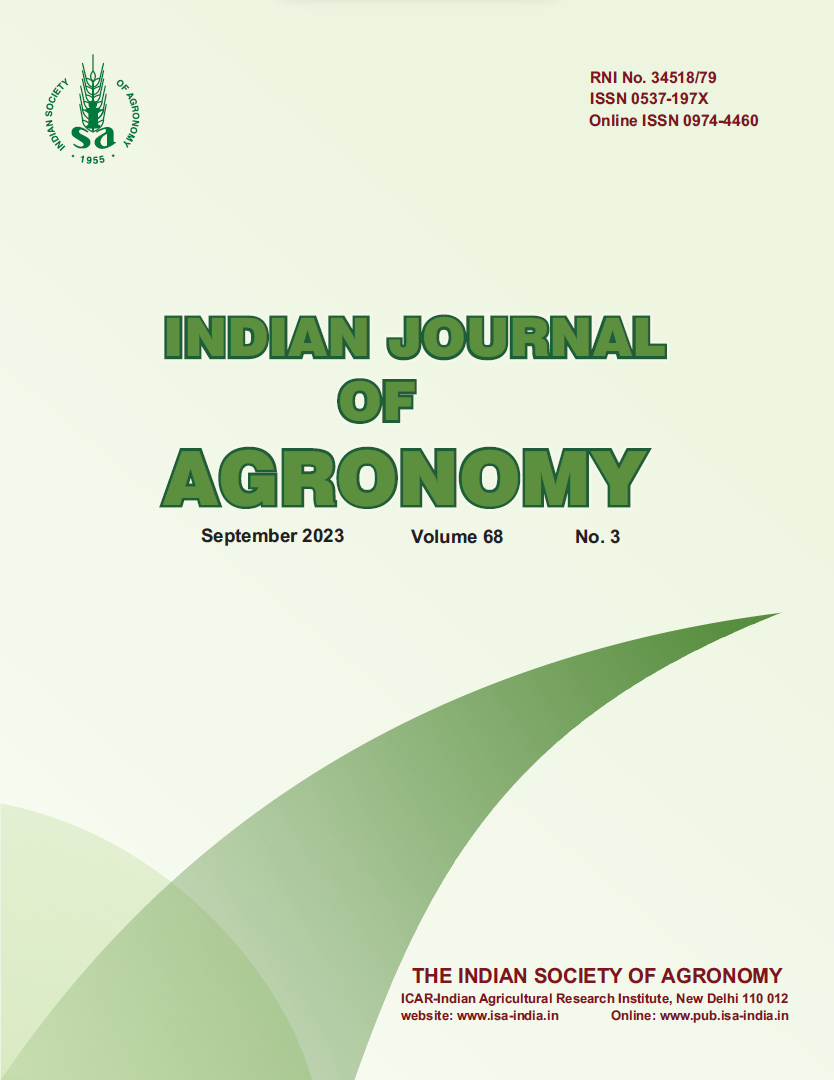Balanced crop nutrition with mid-season foliar fertilization enhances productivity, profitability and partial factor productivity in rainfed castor (Ricinus communis)
DOI:
https://doi.org/10.59797/ija.v68i3.2813Keywords:
Balanced nutrition, Castor, Fertilizer, Foliar, PFP, ProductivityAbstract
A field experiment was conducted at University of Agricultural Sciences, Bengaluru, Karnataka to study the effect of balanced crop nutrition with mid-season foliar fertilization on productivity, profitability, and partial factor productivity of rainfed castor (Ricinus communis L.) during the rainy (kharif) seasons of 2019–20. Significantly higher seed yield (1,604 kg/ha) was observed with 30, 30, 15 and 20 kg N, P2 O5 , K2 O and ZnSO4 through soil followed by foliar application of 2% water-soluble 19 : 19 : 19 at 40 days after sowing which gave 11.38 and 54.37% higher yield over 50, 50 and 25, i.e. 125% recommended dose of fertilizer (RDF) and 40, 40 and 20 (100% RDF) kg N, P2 O5 , K2 O/ha respectively. Foliar application of 2% 19 : 19 : 19 enhanced partial factor productivity (PFP). Higher gross returns (`75,425/ha), net returns (`46,042/ha) and benefit : cost ratio (2.57) were also higher with 30, 30, 15 and 20 kg N, P2 O5 , K2 O, ZnSO4 /ha through soil, followed by foliar application of 2% water-soluble 19 : 19 : 19 at 40 DAS. Therefore, integration of soil and foliar application of plant nutrient looks to be feasible nutrient-management modules of castor in boosting the crop productivity. Further, this nutrient-management module was validated in 50 farmers’ fields with large plot study (0.4 ha) showed 92.26% hike in yield (746 kg/ha) over farmers’ practice (388 kg/ha).
References
Dobermann, A. 2007, Nutrient use efficiency-measurement and management. Proceedings of the International Fertilizer Industry Association (IFA) Workshop on Fertilizer Best Management Practices, pp. 1–28.
FAOSTAT. 2020. Food and Agriculture Statistics. https://www.fao.org/food-agriculture-statistics/en/
Gomez K.A. and Gomez, A.A. 1984. Statistical Procedure for Agricultural Research, edn 2, pp. 963. John Willey, New York,
Harger, N. Brito, O.R. Ralisch, R., Ortiz, F.R. and Watanabe, T.S. 2007, Avaliação de fontes e doses de fósforo no crescimento inicial do milho. Semina: Ciências Agrárias 28: 39–44. https://doi.org/10.5433/1679-0359.2007v28n1p39.
Hiremath, S.M., Kumar, R.M. and Gaddi, A.K., 2016, Influence of balanced nutrition on productivity, economics and nutrient uptake of hybrid maize (Zea mays)–chickpea (Cicer arietinum) cropping sequence underirrigated ecosystem. Indian Journal of Agronomy 61(3): 292–296.
ICAR-IIOR. 2021. Annual Report 2021, ICAR-Indian Institute of Oilseeds Research, Hyderabad, p.152.
Kumar, R.M., Hiremath, S.M. and Nadagouda, B.T. 2015. Effect of single-cross hybrids, plant population and fertility levels on productivity and economics of maize (Zea mays). Indian Journal of Agronomy 60(3): 75–79.
Kumar, N., Pawar, N., Bishnoi, D.K., Bhatia, J. and Kumar, R. 2019. Energy usage and benefit-cost analysis of castor production in Haryana. Economic Affairs 64(4): 789–794.
Kumar, R.M. and Yamanura. 2019. Constraints in castor production and strategies to bridge yield gap in traditional and non-traditional tract of Karnataka. Mysore Journal of Agricultural Sciences 53(3): 49–53.
Kumar, R.M., Yamanura and Boraiah, B. 2021. Performance of elite castor (Ricinus communis L.) hybrids and varieties under rainfed Alfisols. Journal of Oilseeds Research 38(1): 37–43.
Lavanya, C. and Solanki, S.S. 2010. Crop improvement of castor. The challenges ahead (In) Hegde, D.M. (Ed.). Research and Development in Castor. Present Status and Future Strategies. Indian Society of Oilseeds Research, Hyderabad.
Nahar, N. and Pan, W.L. 2015. Urea fertilization: Effects on growth, nutrient uptake and root development of the biodiesel plant, castor bean (Ricinus communis L.). American Journal of Experimental Agriculture 5(4): 320–335.
Nikneshan, P., Tadayyon, A. and Javanmard, M. 2019. Evaluating drought tolerance of castor ecotypes in the center of Iran. Heliyon 5(4): e01403. https://doi.org/10.1016/j.heliyon.2019.e01403
NMOOP. 2018. National Mission on Oilseeds and Oil Palm (NMOOP), Ministry of Agriculture and Farmers Welfare, Government of India, retrieved through https://nmoop.gov.in/
Peuke, A.D., Jeschke, W.D. and Hartung, W.F. 2002. Flows of elements, ions and abscisic acid in Ricinus communis and site of nitrate reduction under potassium limitation. Journal of Experimental Botany 53: 241–250. https://doi.org/10.1093/jexbot/53.367.241
Reddy, K.R. and Matcha, S.K. 2010. Quantifying nitrogen effects on castor bean (Ricinus communis L.) development, growth, and photosynthesis. Industrial Crops and Products 31: 185– 191.
Sangwan P.S., Jhorar, B.S. and Singh, D. 2015. Effect of integrated nutrient management on yield of castor (Ricinus comunis L.) in Typic Ustochrept soil of Hisar, Haryana. Indian Journal of Dryland Agriculture Research and Development 30(2): 68– 73. DOI 10.5958/2231-6701.2015.00028.7
Solanki, S.S. and Joshi, P. 2000. Combining ability analysis over environments of diverse pistillate and male parents for seed yield and other traits in castor (Ricinus communis L.). Indian Journal of Genetics and Plant Breeding 60: 201–212.
Subhash, K. 2002. Effect of planting pattern and fertilizer management on castor (Ricinus communis)-based intercropping system. Indian Journal of Agronomy 47(3): 355–360.
Yamanura and Kumar, R.M. 2020. Study of genetic variability, path coefficient and genetic diversity in castor (Ricinus communis L.). The Pharma Innovation Journal 9(8): 285– 292.
Yin, X., Lu, J., Agyenim-Boateng, K.G. and Liu, S. 2019. Breeding for Climate resilience in castor: current status, challenges, and opportunities. Genomic Designing of Climate-Smart Oilseed Crops, Switzerland: Springer, pp. 441–498.






